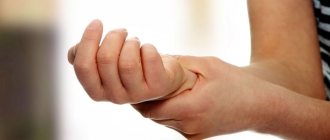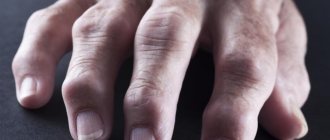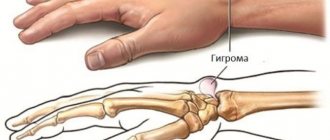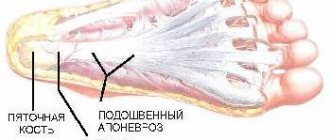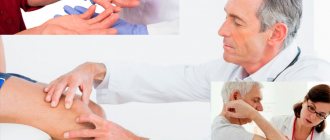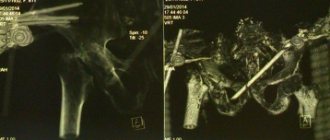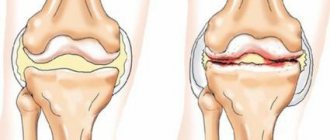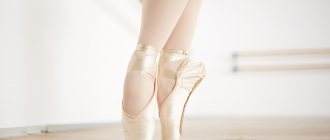General information about the disease
Arthritis of the fingers is an inflammation of the metacarpophalangeal and interphalangeal joints of the fingers. The disease occurs quite often at any age. According to statistics, women over 40 years of age are more affected by it. This is explained by the fact that, compared to men, women have a greater load on their hands and fingers. ICD-10 code for finger arthritis of unspecified origin M13.
Depending on the cause that caused it, the disease can occur only in small joints of the fingers, or can be combined with damage to large joints. The onset of the disease can be acute, subacute and chronic, but then the course in most cases becomes protracted or chronic. The exception is post-traumatic arthritis of the fingers: with proper treatment, it ends in complete recovery. But if treatment was not prescribed on time, it also takes a chronic course.
Causes of inflammation in the joints of the fingers
The causes of the disease can be different. Most often, the small joints of the fingers are affected by rheumatoid arthritis, an autoimmune (allergy to the patient’s own tissues) disease, which is based on a hereditary predisposition. The starting point for the onset of the disease is usually some kind of infection. After some time, genetically predisposed individuals develop arthritis of the fingers. In the future, other, larger joints may be affected.
Another common cause of inflammation in the small joints of the hands is psoriatic arthritis. It is also an autoimmune hereditary disease that mainly affects the joints of the fingertips (distal) with simultaneous characteristic lesions of the nails. This usually occurs against the background of existing skin manifestations of psoriasis, but sometimes symptoms of arthritis in the joints of the fingers appear first.
Quite often, arthritis of the finger joints develops with gout. The disease has a metabolic (metabolic) origin - the metabolism of uric acid salts is disrupted, they are deposited in the articular and periarticular tissues, causing an inflammatory process.
Post-traumatic arthritis of the finger joints is sometimes of an occupational nature. It develops with constant minor trauma to the hands of jewelers, seamstresses, hairdressers, etc. The inflammatory process is constantly supported by additional trauma and becomes chronic. After acute (sports, household) injuries, acute arthritis can develop, which then completely disappears.
Other types of arthritis rarely cause damage to small joints. Provoking factors that contribute to the development of arthritis in the small joints of the hands are hormonal changes (adolescence, pregnancy, menopause), stress, frequent colds and allergies, bad habits, and professional activities.
Causes
The main reason for the development of such defects is not only vascular diseases. Often, trophic ulcers occur against the background of neoplasms localized in the axillary, subclavian and mediastinal lymph nodes. In addition, injuries of various types (stabbed, cut, chopped, bitten), infectious and inflammatory diseases (chickenpox, helminthic infestations), pathologies of the immune system, systemic connective tissue diseases (lupus erythematosus, vasculitis), sepsis cause aggravation of the skin syndrome and the development ulcerative defects on the hands.
Symptoms of arthritis in the fingers
Symptoms can be different, they depend on the nature of the inflammatory process (acute, subacute, chronic), as well as on the clinical form of the underlying disease.
First signs
Swelling and aching pain are the first signs of hand arthritis
The onset of the disease is slow in most cases. There are aching pains in the hands and stiffness of movements in the morning. At first, this symptom lasts on average no more than half an hour, and then goes away. The pain is aching, constant, and its intensity increases slowly.
Less often the onset is acute. Pain appears in one or more small finger joints, accompanied by redness and swelling of the surrounding tissues. The function of the joint is impaired: it is difficult to bend and unbend, sometimes it is impossible to do this due to pain.
With the acute onset of the disease, the patient’s general condition often suffers: fever, malaise, and headache appear. If the process develops subacutely or chronically, there may be no general manifestations; changes in the affected joints may also not be too pronounced.
The most important thing to do if you experience symptoms of arthritis is to seek medical help. The sooner this happens, the greater the chance of stopping the inflammatory process at the very beginning.
Obvious symptoms
Obvious signs of chronic hand arthritis include the appearance of swelling and redness of the tissues around the affected areas of the hands, as well as the involvement of other joints in the pathological process on the same or another hand. The appearance of new foci of inflammation may be accompanied by a slight rise in body temperature, increased pain and dysfunction of the affected joints. But more often, rheumatoid exacerbations occur without general manifestations.
After some time, the inflammatory process may somewhat reduce intensity, local inflammation and general symptoms decrease. After this, the process becomes chronic. Morning stiffness of movement appears, patients note the feeling of tight gloves on their hands, which do not allow them to move. Some time after getting up in the morning and starting physical activity, this feeling decreases or even disappears. The appearance of crepitus (friction and clicking) in the affected articular joints is also characteristic.
When the patient does not receive treatment for arthritis, there is an alternation of exacerbations and remissions with constant pain and rapid formation of joint deformation (with rheumatoid arthritis) or melting of the fingertips with their shortening (with psoriatic arthritis). Arthritis of the thumb most often develops with gout, occurs with severe pain, swelling, redness, then goes away without a trace, but with frequent relapses, deformation and loss of function of the joint also develops.
Dangerous symptoms
Emergency medical attention is required if the following symptoms of finger arthritis appear:
- high body temperature (38 - 39°) for 5 or more days;
- a sharp rise in temperature, increased inflammation and pain in the joint with an already existing inflammatory process - may indicate the onset of suppuration;
- involvement of new small or large joints in the pathological process;
- the appearance of blackened tissue on the fingertips (necrosis) in psoriatic arthritis.
If such symptoms appear, you should immediately consult a doctor.
How dangerous is the disease?
The main danger of any type of chronic arthritis is the progression of the inflammatory process, which over time becomes degenerative-dystrophic with deformation of the limbs and disability. The longer arthritis lasts, the higher the risk of complications.
Stages of the disease
Any form of arthritis has serious complications, so you should not delay treatment.
See how easily the disease can be cured in 10-12 sessions.
Arthritis of the joints of the fingers has 4 stages of development depending on the degree of joint damage detected during instrumental examination:
- Initial stage
. If there are pronounced or minor clinical signs of inflammation, an x-ray can show signs of inflammation in the form of widening of the joint space. An ultrasound can show the presence of an increased volume of joint fluid. Symptoms can be pronounced or almost absent in the chronic course of the disease. - Progressive inflammation.
Signs of inflammation are clearly visible on x-rays and ultrasound. Articular cartilage is destroyed, and in its place loose connective tissue - pannus - is formed. The process takes on a wave-like (exacerbation-remission) or constantly progressive course. Pain and stiffness of movement increase. - Connective tissue ankylosis.
The connective tissue of the pannus becomes rough, it grows and connects the joint-forming bone surfaces with each other, as a result of which movement in the joint is limited. Fingers become deformed. - Bone ankylosis.
Instead of connective tissue, bone tissue grows in the joint, which leads to complete immobility of the joint and loss of its function.
Possible complications
If arthritis of the hands and fingers is not treated, the disease will progress. The following complications are also possible:
- development of a purulent inflammatory process with transition to the tissue surrounding the joint, development of abscesses, phlegmon and sepsis;
- necrosis of the fingertips, their shortening and inflammation of the soft tissues;
- subluxations and dislocations of small joints;
- various types of joint deformities;
- complete loss of function of the fingers and hands.
What to do during an exacerbation
You can get rid of pain from arthritis of the hands with the help of drugs from the group of non-steroidal anti-inflammatory drugs
When arthritis worsens, the joints become sharply painful, the skin over them turns red, swells, and movements in the fingers become impossible due to pain. To reduce suffering you need to:
- give your hands a slightly elevated position - this will reduce swelling;
- take any medicine from the group of non-steroidal anti-inflammatory drugs (NSAIDs) - Diclofenac, Nise, Indomethacin, Ibuprofen; this will reduce pain and inflammation;
- apply any external agent from the NSAID group - gel or ointment - to the skin over the diseased joint; emulgel Voltaren helps a lot;
- consult a doctor or call him at home.
During an exacerbation, you cannot delay visiting a doctor; it is urgent to suppress the progression of the disease. It is impossible to do this on your own.
Education mechanism
As a result of exposure to the causative factor, the pressure in the venous capillaries of the upper extremities increases, and they begin to change their shape and direction. They become crimped and thinned. Their permeability increases, fibrin and blood clots are deposited between the venous vessels. This leads to hypoxia (low oxygen saturation of the blood vessels). The level of blood circulation decreases sharply, causing ischemia (circulatory failure). A prolonged absence of normal blood circulation provokes the development of necrotic processes. Plaques of various shapes form on the hands, which over time either dry out and turn into a dry form of necrosis or begin to quickly increase, reaching large sizes.
How does arthritis of the fingers proceed in different clinical forms of the disease?
The symptoms of hand arthritis and the nature of its course depend on the disease that led to its development. Damage to small joints of the hands is most often found in rheumatoid, psoriatic and gouty arthritis. But it can also occur in other clinical forms of arthritis.
Rheumatoid arthritis
In most cases, arthritis begins slowly and unnoticeably. Aching pain appears in the fingers. The nature of the pain is constant, aching, exhausting. In the morning after sleep, stiffness of movement appears, which can last up to 30 minutes or more.
After some time, the patient notices that the fingers begin to swell in the joints. Most often, the metacarpophalangeal and overlying interphalangeal joints of the 2nd and 3rd fingers are affected. The lesion is symmetrical on both hands. Pain of varying degrees of intensity is constant. Over time, characteristic spindle-shaped finger deformations appear
Small, painless subcutaneous rheumatoid nodules appear on the skin of the fingers and in the elbow area. The course of the disease is slow, steadily progressing, accompanied by constant debilitating pain, deformities and loss of joint function.
Psoriatic arthritis
Pictured is rheumatoid and psoriatic arthritis of the hands
With this disease, arthritis develops in the distal (end) interphalangeal finger joints against the background of existing skin manifestations of psoriasis. But sometimes joint symptoms appear before skin symptoms or simultaneously with them. The disease in most cases begins acutely or subacutely with the appearance of redness, swelling and pain in the small finger joints. The lesion is usually asymmetrical, with the fingers resembling sausages.
The disease occurs with severe exacerbations and remissions. Nail plates are almost always involved in the pathological process. Over time, deformation of the fingertips occurs, they thicken, the nails become thinner and also deformed, and a symptom of a thimble appears - pinpoint depressions on the nail plates.
With a long course of the disease, dislocations and subluxations of small distal joints develop, as well as lysis (melting) of the bones of the fingertips (radiological sign) and shortening of the fingers.
Chondroprotectors: what are they, how to choose, how effective are they?
Joint pain at rest
Gouty arthritis
An attack of gout begins acutely, with the appearance of severe pain, swelling and redness in the affected joints. Small joints are often involved. Typically, inflammation begins with the metacarpophalangeal joint of the 1st finger, and then can spread to the metacarpophalangeal and interphalangeal joints of other fingers.
The pain is very severe, the attack can last from several hours to several weeks, and then everything goes away. But with frequent attacks affecting the same joints, their function is impaired.
Post-traumatic arthritis
This type of arthritis of the fingers can develop against the background of an acute domestic, industrial or sports injury, occur acutely with subsequent complete recovery, or (in the absence of the necessary help) be complicated by the addition of a purulent infection. Sometimes such an inflammatory process can become chronic with subsequent deformation of the affected joints.
Initially, post-traumatic arthritis of the fingers takes a chronic course with constant minor unnoticeable injury to the fingers. Most often this occurs among people in certain professions who perform minor work. Arthritis develops slowly, affecting the joints that are most injured during work. If you do not change jobs, a permanent deformity develops with impaired finger function.
Other types of arthritis
With such types of arthritis as reactive, infectious, idiopathic, damage to the small joints of the fingers practically does not occur.
Diagnostics
The diagnosis is established based on the characteristic symptoms of the disease and is confirmed by examination data:
- laboratory tests - detect the presence of an inflammatory process, the presence or absence of infection, antibodies to infectious agents, rheumatoid factor;
- X-ray – reveals bone changes in joints;
- Ultrasound - the presence of an increased volume of exudate in the joint cavity is a sign of an active inflammatory process;
- MRI – changes in soft articular and periarticular tissues.
Without additional examination methods, it is impossible to establish the correct diagnosis (and therefore prescribe adequate treatment). Therefore, if you experience pain in the small joints of your fingers, you should consult a doctor as soon as possible.
Treatment of arthritis of the fingers
After a final diagnosis has been established, treatment for arthritis of the fingers is prescribed, which is carried out by a rheumatologist (sometimes together with other specialists - a surgeon, a dermatovenerologist). It should be comprehensive, aimed at suppressing the progression of the pathological process and preventing disorders of joint function. The complex treatment includes:
- drug therapy;
- physiotherapeutic procedures;
- therapeutic exercises and massage;
- reflexology courses;
- folk remedies.
Drug therapy
The primary goal of drug therapy is to alleviate the condition of a sick person. For this purpose, NSAID medications are prescribed to relieve pain, inflammation and tissue swelling. Depending on the degree of activity of the inflammatory process, these drugs are prescribed in the form of injections (shots) or tablets for oral administration. In addition, drugs in this group are prescribed externally in the form of gels, ointments and creams.
The most effective NSAID is Diclofenac, but it has an irritating effect on the walls of the gastrointestinal tract, so it cannot be taken for a long time. Instead of Diclofenac, more modern drugs of the NSAID group are prescribed - Nise, Celebrex, etc. Such products as Pentalgin gel and Diclofencac ointment are used externally. The best ointment for arthritis of the fingers is Voltaren emulgel. The use of NSAIDs can bring significant relief to the patient.
Drugs for the treatment of hand arthritis
Sometimes the inflammatory process is so severe that it cannot be relieved with NSAID medications. In this case, glucocorticoid hormones are used - Prednisolone, Dexamethasone, etc. in the form of injections, orally in tablets or externally in the form of ointments. Intra-articular injection of hormones into small joints is rarely practiced.
To suppress autoimmune processes, basic group drugs are prescribed - Methotrexate, Sulfasalazine, Leflunomide and biological agents (MabThera, Redditux). These drugs are selected by a rheumatologist and prescribed according to a special regimen in long courses.
To restore joint function, chondroprotectors are prescribed - medications that restore the cartilage tissue of joints (Dona, Structum, etc.). They are also prescribed in long courses.
Agents that improve blood circulation and metabolism in tissues - Pentoxifylline, Actovegin, etc. help restore tissue trophism.
Vitamins and minerals are prescribed as general tonics, improving metabolism and helping to restore overall balance in the body.
Physiotherapeutic procedures
The complex treatment of arthritis of the fingers necessarily includes physiotherapeutic procedures. They, just like medications, are selected individually depending on the clinical form and activity of the pathological process. This can be electrophoresis with Hydrocortisone, UHF, laser or magnetic therapy, etc.
Crunching in joints - when to worry
Intra-articular injections of hyaluronic acid
Massage and exercise therapy
Courses of massage and therapeutic exercises are prescribed during the period of subsidence of the inflammatory process. They help improve blood circulation and metabolism in tissues, restore the function of small joints. At home, you can do the following physical exercises to improve mobility:
- roll a small elastic ball on the table surface with your finger surfaces for a minute, actively involving the affected finger joints in the process;
- with the fingertips of one hand, touch the pad of the 1st finger of the opposite hand; start with the little finger and end with the index finger; repeat the exercise 10 times;
- position your hands so that your fingertips are slightly bent and touch the surface of the table; bend each finger in turn and hit the table with it (like the keys of a piano);
- repeat three times.
Such exercises should be done daily, gradually increasing the number of approaches.
Folk remedies
A doctor should tell you how to treat arthritis of the fingers with folk remedies. He also selects the most suitable method. You can use both herbal decoctions and infusions for oral administration and external agents:
- a compress of kefir mixed with crushed chalk at the rate of 50 g of chalk per 75 - 100 ml of kefir; You should get a thick mixture that needs to be applied once a day at night; to do this, you need to apply it on a cotton napkin, apply it to the sore spot, and put polyethylene and insulation on top; leave it like that all night; perfectly relieves swelling and pain;
- infusion of celery roots; Place 20 g of crushed raw materials (dry or fresh) in a thermos overnight, pour 200 ml of boiling water; the next day, drink 3 to 4 times before meals; course of treatment – 2 weeks; relieves pain and swelling well.
Surgery
This type of treatment for arthritis of small joints is rarely used. In cases of severe arthritis that cannot be treated conservatively, a synovectomy is sometimes performed - removal of part of the synovial membrane that produces a large volume of exudate.
In some cases, the joint is replaced with an artificial one, but this is a fairly rare operation.
Modern treatment strategy for rheumatoid arthritis in this article.
How to treat finger arthritis
Rheumatologists treat arthritis of the fingers. After diagnosis, they will determine the stage of the disease and appropriate treatment. Arthritis of the fingers, regardless of the cause, is treated comprehensively. The duration of treatment varies from case to case - from a few weeks to lifelong.
Treatment for arthritis of the fingers is a long and ongoing process.
Treatment of arthritis of the fingers with medications
For the medical treatment of arthritis of the fingers, the following groups of drugs are used:
- Nonsteroidal anti-inflammatory drugs (NSAIDs). They help reduce pain and inflammation, remove swelling and restore nutrition to the cartilage. NSAIDs are used both externally (ointments, gels, creams) and internally - in the form of tablets for arthritis of the fingers, intramuscular and intra-articular injections. At the same time, the doctor may prescribe antihistamines and other drugs, incl. to protect the gastric mucosa.
- Vasodilators. They help relieve spasms and improve nutrition of the joint and adjacent soft tissues.
- Chondroprotectors. Preparations based on chondroitin and glucosamine promote healthy synthesis of cartilage tissue, accelerate its recovery and protect cartilage cells from destruction.
- Glucocorticosteroids. Hormonal drugs for the treatment of arthritis of the fingers are prescribed only in cases where NSAIDs are ineffective. They radically eliminate pain and reduce inflammation in severe conditions.
- Vitamins and restoratives, as well as calcium supplements.
- Antibiotics. Used in cases of arthritis of an infectious nature.
Before treating arthritis in your finger joints, consult your doctor.
Tablets for arthritis of fingers
In the “home” treatment of arthritis of the joints of the fingers, drugs such as naproxen, nimesulide, paracetamol, ketorolac, piroxicam, ibuprofen, ketoprofen, meloxicam, metamizole help. Among chondroprotectors, artracam, structum, and dona are especially effective.
Local medications for the treatment of arthritis of the fingers
In the drug treatment of arthritis of the fingers, Voltaren, Dolobene, Fastum Gel, Ketonal, Viprosal, Nicoflex and others, as well as ointments based on bee or snake venom, are widely used. The ointment is applied to clean, dried skin and gently rubbed until completely absorbed.
Physiotherapy for arthritis of the fingers
Physiotherapy is almost mandatory for arthritis of the fingers. However, not all methods of physiotherapy are applicable during exacerbation of the disease - before starting physiotherapeutic treatment for arthritis of the joints of the fingers, you must consult a doctor.
The following methods are most effective:
- magnetic therapy;
- ultraviolet irradiation;
- medicinal electrophoresis;
- phonophoresis;
- laser therapy;
- UHF;
- reflexology;
- balneotherapy and mud therapy;
- paraffin therapy;
- manual therapy;
- massage for arthritis of fingers.
Gymnastics for fingers for arthritis
During the day - at least 3-4 times - it is worth doing simple finger exercises:
- Rub your palms together vigorously until a feeling of warmth appears.
- Clench and unclench your fists (5-10 times). Then twist them clockwise and counterclockwise.
- Try to touch the base of your palm with your fingertips - stretch the muscles on the back of the hand well (5 times).
- Reach the tip of your thumb to the base of your little finger (7-10 times).
- Stretch your arms in front of you and turn your hands with your palms up and down (7-10 times).
- Move up and down and in circles with each finger.
For gymnastics for fingers with arthritis, choose a soft ball or ring to squeeze and unclench it - for example, while talking on the phone. Modeling from clay or plasticine is also useful.
How to relieve pain from arthritis of fingers
In addition to ointments and gels, which have a warming and irritating effect, folk remedies for arthritis of the fingers help reduce pain - warm baths for the hands, incl. with chamomile, St. John's wort and other beneficial herbs. If your joints are very inflamed and swollen, apply ice to them for 5-6 minutes to reduce swelling and restore nutrition.
Rubbing and self-massage also helps with arthritis of the finger joints. Massage each finger from base to tip and knead the brush. Massage with gel after baths is especially effective for arthritis of the fingers.
Approach to the treatment of arthritis of the fingers at the Paramita clinic
.
In our clinic, the patient is thoroughly examined using the latest laboratory and instrumental methods, including MRI, and only after that is treatment individually selected for each patient prescribed.
A special feature of treatment in our clinic is that complex therapy includes:
- modern Western methods of treatment
, allowing to eliminate the main manifestations of arthritis of the fingers; - traditional oriental methods of treating diseases
, allowing to restore balance in the body, establish the relationship of all organs and systems; this leads to the elimination of inflammation, swelling and pain in the joints and suppresses the progression of the disease.
The combination of Western and Eastern techniques makes it possible to quickly and painlessly relieve our patients of pain, and then effectively restore the function of damaged joints. The specialists at the Paramita Clinic have extensive experience in treating arthritis of the fingers. You can find out more about treatment methods in our clinic on our website.
We combine proven techniques of the East and innovative methods of Western medicine.
Read more about our unique method of treating arthritis
Treatment
After identifying the main cause that led to the development of trophic ulcers on the hands, adequate therapeutic measures are selected. For antibacterial purposes, antibiotics are prescribed - Ceftriaxone, Amoxicillin, Tetracycline. Venarus and Detralex are used to strengthen blood vessels and restore impaired blood flow. For shallow/superficial ulcerative defects, the use of healing ointments is recommended for topical application. These include Zinc ointment, Argosulfan, Solcoseryl and Levomekol.
Surgical treatment consists of excision of the edges of the ulcer and rinsing with antiseptic drugs (Betadine, Furacillin). If purulent contents are present, drainage is installed.
General clinical recommendations
For patients suffering from arthritis of the fingers, it is recommended:
- lead a healthy lifestyle, toughen up;
- be treated in a timely manner, eliminate all foci of infection that may become a trigger in the development of exacerbations of arthritis;
- get rid of bad habits;
- eat right, regulate sleep and wakefulness;
- if arthritis worsens, do not put stress on your fingers, do not do housework, including washing dishes;
- during remission, do physical exercises for your arms at home; classes should be held daily;
- completely abandon self-medication and adhere to the doctor’s recommendations in everything.
Prevention of arthritis of the fingers
Preventing arthritis is especially important for people who have a genetic predisposition to this disease (close relatives with this pathology). In order to maintain health, they need to adhere to the following recommendations:
- you should not overload your hands with heavy physical or long-term painstaking work, including at home;
- you should not overcool, you should avoid overcooling your hands;
- lead a healthy lifestyle, eat right, toughen up;
- engage in feasible sports, conduct daily training;
- avoid prolonged stress.
Diet
Special nutrition is required only for gouty arthritis of the fingers. The diet of such patients should not contain strong broths, offal, meat of young animals, alcohol, sorrel, lettuce, strong tea, coffee, or chocolate.
If you have gouty arthritis, you should follow a diet
In other cases, it is enough to adhere to the principles of a healthy diet: eat lean meat and dairy products, fish (fatty sea fish is healthy), grains, cereals, vegetables, and fruits. High-calorie foods, sweets, baked goods, spicy seasonings, fried and smoked foods should be avoided. Meals should be regular.
Psoriasis vs urticaria - how to distinguish them?
IMPORTANT! Description/text of inset
However, knowing about the differences in the manifestations of urticaria and psoriasis is very useful, if only to help the doctor draw up a complete clinical picture.
Form of rash:
- In psoriasis, the plaques are slightly elevated, have clear boundaries and characteristic silvery scales. As the inflammation worsens, the foci of inflammation begin to grow and merge into spots, and may also bleed. The surface of the rash is drier than on other areas of the skin.
- Hives rashes, especially if it is an allergic reaction, do not have clear contours and can appear in the form of small and large spots. In severe cases, continuous swelling may occur. The rashes do not have dryness, as with psoriasis.
Localization of rashes:
- Psoriatic rashes appear on limited areas of the body, most often in the scalp, back and sacrum, bends of the knees and elbows. Less often - in the genital area, in the groin, axillary area and on the chest.
- Hives rashes can appear on any part of the body.
Itching:
- With psoriasis, most often the itching in the area of the rash is quite moderate.
- Hives cause severe itching. Just like after a thicket of nettles, remember?
Specific symptoms of psoriasis also include swelling of the joints and thickening of the nail plate.
How to treat?
If you have hives that occur sporadically as an allergic reaction, you may forget about it forever once you find out with the help of a doctor what allergen is causing it. In this case, you will have to give up some products and minimize contact with pets. Your doctor may also prescribe antihistamines, anti-inflammatory steroids, antidepressants, or sedatives if your hives are a reaction to stress.
In order to get rid of the symptoms of psoriasis and achieve remission, you will have to undergo serious treatment. Such patients are prescribed corticosteroids, retinoids, and phototherapy using ultraviolet light. And, of course, you will have to make serious adjustments to your lifestyle: minimize alcohol consumption, eat a balanced diet and learn to manage your stress.
Frequently asked questions about the disease
Which doctor should I see for arthritis of the fingers?
It is better to immediately see a rheumatologist; if necessary, he will refer you for consultation to another specialist.
Can folk remedies be used for treatment?
You can, but not on your own, but only as prescribed by a doctor.
Rheumatologists often prescribe hormonal drugs; are they harmful?
Hormones are prescribed in short courses to eliminate pain and swelling. Such treatment cannot harm.
Arthritis of the fingers often develops unnoticed. It is very important to pay attention to aching pain in your fingers in a timely manner and consult a doctor in a timely manner. But even if you have missed time and obvious signs of arthritis appear, do not despair: you can help at any stage. It is difficult to completely cure a chronic disease, but it is quite possible to stop its progression, relieve you of pain and improve your quality of life. Doctors at the Paramita clinic (Moscow) know how to do this.
Literature:
- Zabolotnykh, I.I. Diseases of the joints / I.I. Zabolotnykh. - M.: SpetsLit, 2009. - 256 p.
- Velyaminov, N.A. The doctrine of joint diseases from a clinical point of view / N.A. Velyaminov. - M.: State Publishing House, 2011. - 434 p.
- Shostak N. A. Psoriatic arthritis: new approaches to treatment // Clinician. 2008. No. 2. P. 41–45.
Themes
Arthritis, Joints, Pain, Treatment without surgery Date of publication: 11/13/2020 Date of update: 04/03/2021
Reader rating
Rating: 4.6 / 5 (5)
